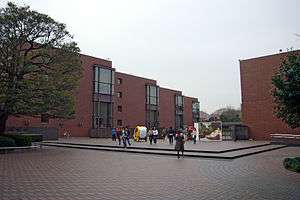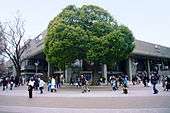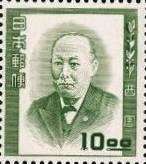Ueno Park
| Ueno Park | |
|---|---|
|
Visitors enjoying the cherry blossoms | |
| Location | Taitō, Tokyo, Japan |
| Coordinates | 35°42′44″N 139°46′16″E / 35.71222°N 139.77111°ECoordinates: 35°42′44″N 139°46′16″E / 35.71222°N 139.77111°E |
| Area | 538,506.96 square metres (133.06797 acres) |
| Created | 19 October 1873[1] |
| Public transit access | Ueno Station |
Ueno Park (上野公園 Ueno Kōen) is a spacious public park in the Ueno district of Taitō, Tokyo, Japan. The park was established in 1873 on lands formerly belonging to the temple of Kan'ei-ji. Amongst the country's first public parks, it was founded following the western example as part of the borrowing and assimilation of international practices that characterizes the early Meiji period. The home of a number of major museums, Ueno Park is also celebrated in spring for its cherry blossoms and hanami. In recent times the park and its attractions have drawn over ten million visitors a year, making it Japan's most popular city park.[2]
History
Ueno Park occupies land once belonging to Kan'ei-ji, founded in 1625 in the "demon gate", the unlucky direction to the northeast of Edo Castle.[3] Most of the temple buildings were destroyed in the Battle of Ueno in 1868 during the Boshin War, when the forces of the Tokugawa shogunate were defeated by those aiming at the restoration of imperial rule. In December of that year Ueno Hill became the property of the city of Tokyo, other than for the surviving temple buildings which include the five-storey pagoda of 1639, the Kiyomizu Kannondō (or Shimizudō) of 1631, and approximately coeval main gate (all designated as Important Cultural Properties of Japan).[2][4][5][6]
Various proposals were put forward for the use of the site as a medical school or hospital, but Dutch doctor Bauduin urged instead that the area be turned into a park.[7] In January 1873 the Dajō-kan issued a notice providing for the establishment of public parks, noting that "in prefectures including Tokyo, Osaka, and Kyoto, there are places of historic interest, scenic beauty, and recreation and relaxation where people can visit and enjoy themselves, for example Sensō-ji and Kan'ei-ji..."[8][9] This was the year after the foundation of Yellowstone, the world's first national park.[10]
Later that year Ueno Park was established, alongside Shiba, Asakusa, Asukayama, and Fukugawa Parks.[7][11] It was administered first by the Home Ministry's Museum Bureau, then by the Ministry of Agriculture and Commerce, before passing to the Ministry of the Imperial Household. In 1924, in honour of the marriage of Hirohito, Ueno Park was presented to the city by Emperor Taishō, receiving the official name that lasts to this day of Ueno Onshi Kōen (上野恩賜公園), lit. "Ueno Imperial Gift Park".[8]
Natural features
The park has some 8,800 trees, including Ginkgo biloba, Cinnamomum camphora, Zelkova serrata, Formosan cherry, Somei-Yoshino cherry, and Japanese cherry. There is a further 24,800 m2 of shrubs.[1] Shinobazu Pond is a small lake with an area of 16 ha, extensive lotus beds, and marshland. It provides an important wintering ground for birds. Species commonly found include the tufted duck, Eurasian wigeon, northern pintail, common pochard, little grebe, great egret, and great cormorant. The Baer's pochard, ring-necked duck, and American wigeon have also been recorded.[12]
The central island houses a shrine to Benzaiten, goddess of fortune, modelled on Chikubu Island in Lake Biwa.[13] The area was once full of "rendezvous teahouses", equivalent of the modern love hotel.[13] After the Pacific War the pond was drained and used for the cultivation of cereals and subsequently there were plans to turn the site into a baseball stadium or multi-storey carpark.[14] The lotus pond was restored in 1949, although much of it was again accidentally drained in 1968 during work on a new subway line.[14]
In all there are some eight hundred cherry trees in the park, although with the inclusion of those belonging to the Ueno Tōshō-gū shrine, temple buildings, and other neighbouring points the total reaches some twelve hundred.[11] Inspired, Matsuo Bashō wrote "cloud of blossoms - is the temple bell from Ueno or Asakusa".[15]
Cultural facilities
Ueno Park is home to a number of museums. The very words in Japanese for museum as well as for art were coined in the Meiji period (from 1868) to capture Western concepts after the Iwakura Mission and other early visits to North America and Europe.[18] The Tokyo National Museum was founded in 1872 after the first exhibition by the Museum Department of the new Ministry of Education.[19] In the same year the Ministry of Education Museum opened, now the National Museum of Nature and Science.[20]
The National Museum of Western Art was founded in 1959 based on the collection of Matsukata Kōjirō, returned by the French government after the Treaty of San Francisco.[21][22] The building is by Le Corbusier who used it to express his concept of the Museum of Unlimited Growth, based on an expanding spiral.[23] It has been nominated for inscription on the UNESCO World Heritage List.[24]
Other museums include the Tokyo Metropolitan Art Museum, dating back to 1926, and Shitamachi Museum of 1980, which is dedicated to the culture of the "Low City".[25][26] The park was also chosen as home for the Japan Academy (1879), Tokyo School of Fine Arts (1889), and Tokyo School of Music (1890).[2] The first western-style concert hall in the country, the Sōgakudō Concert Hall of 1890 (ICP) was donated to the ward in 1983 and reconstructed on another site in the park, where it is used for concerts.[27][28] The Tokyo Bunka Kaikan opened in 1961 as a venue for opera and ballet, in celebration of the five hundredth anniversary of the foundation of the city of Edo.[29] The Imperial Library was established as the national library in 1872 and opened in Ueno Park in 1906; the National Diet Library opened in Chiyoda in 1948 and the building now houses the International Library of Children's Literature.[30][31]
Other points of note
Tokugawa Ieyasu is enshrined at Ueno Tōshō-gū, dating to 1651.[32] Gojōten Jinja is dedicated to scholar Sugawara no Michizane, while neighbouring Hanazono Inari Jinja has red-bibbed Inari fox statues in an atmospheric grotto.[33][34] There is a Yayoi-period burial mound on a small hill near the park's centre.[11] For a decade until 1894 there was horse racing near Shinobazu Pond.[7][8] Nowadays there is a baseball field, named in honour of poet Masaoka Shiki, fan of the sport.[11] As well as the first art museum in Japan, the park had the first zoo, first tram, first May Day celebrations (in 1920), and staged a number of industrial expositions.[7][8] Ueno Station opened nearby in 1883.[35] After the Great Kantō earthquake in 1923, notices of missing persons were attached to the statue of Saigō Takamori.[8] Ueno Park and its surroundings figure prominently in Japanese fiction, including The Wild Geese by Mori Ōgai.
Homeless
Many homeless people squat in Ueno Park. Found among the park's treelines and wooded areas, homeless camps border on the size of small villages, with an internal structure, culture, and support system. The long-term shelters are typically constructed of cardboard covered with blue tarps. The police occasionally tear down the camps and drive out or arrest the homeless, who return as soon as they can. While squatting is illegal in Japan, homelessness is seen as an endemic problem in Tokyo and other cities, and the presence of squatters is accepted as an inevitability.[36]
Cultural facilities, monuments, and attractions
-
The University Art Museum, Tokyo University of the Arts
-
Ueno Royal Museum
-
Kan'ei-ji Hondō
-

Ueno Tōshō-gū
-
Tokugawa mausoleum
-
.jpg)
Gojōten Jinja (Hanazono Inari Jinja)
-
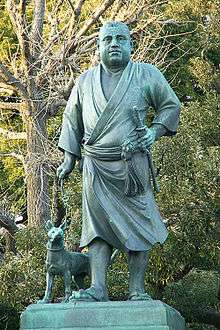
Statue of Saigō Takamori walking his dog
-

Equestrian statue of Prince Komatsu Akihito
-

Statue of Hideyo Noguchi
-
Remains of the Ueno Daibutsu
-
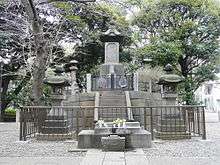
Monument to the Shōgitai
-
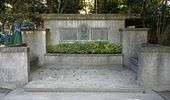
Monument to Ulysses Grant
-

Statue of Bauduin
-

Kuroda Memorial Hall, National Research Institute for Cultural Properties, Tokyo
See also
| Wikimedia Commons has media related to Ueno Park. |
References
- 1 2 上野恩賜公園 [Ueno Park] (in Japanese). Tokyo Metropolis. Retrieved 4 March 2012.
- 1 2 3 Havens, Thomas R. H (2011). Parkscapes: Green Spaces in Modern Japan. University of Hawaii Press. pp. 28ff. ISBN 978-0-8248-3477-7.
- ↑ Jinnai Hidenobu (1995). Tokyo: A Spatial Anthropology. University of California Press. p. 15. ISBN 0-520-07135-2.
- ↑ "旧寛永寺五重塔" [Former Kan'ei-ji five-storey pagoda]. Agency for Cultural Affairs. Retrieved 8 March 2012.
- ↑ "寛永寺清水堂" [Kan'ei-ji Shimizudō]. Agency for Cultural Affairs. Retrieved 8 March 2012.
- ↑ "寛永寺旧本坊表門 (黒門)" [Former Kan'ei-ji Omotemon (Kuromon)]. Agency for Cultural Affairs. Retrieved 8 March 2012.
- 1 2 3 4 Seidensticker, Edward (2010). Tokyo from Edo to Showa 1867-1989: The Emergence of the World's Greatest City. Tuttle Publishing. pp. 125ff. ISBN 978-4-8053-1024-3.
- 1 2 3 4 5 "Ueno Park". National Diet Library. Retrieved 3 March 2012.
- ↑ 公園緑地年表 [Parks - Chronology] (in Japanese). Ministry of Land, Infrastructure, Transport and Tourism. Retrieved 8 March 2012.
- ↑ Sutherland, Mary; Britton, Dorothy (1995). National Parks of Japan. Kodansha. p. 6. ISBN 4-7700-1971-8.
- 1 2 3 4 "Ueno Park" (PDF). Tokyo Metropolis. Retrieved 8 March 2012.
- ↑ "Japan - Introduction" (PDF). Ramsar. Retrieved 4 March 2012.
- 1 2 Jinnai Hidenobu (1995). Tokyo: A Spatial Anthropology. University of California Press. p. 110. ISBN 0-520-07135-2.
- 1 2 Seidensticker, Edward (2010). Tokyo from Edo to Showa 1867-1989: The Emergence of the World's Greatest City. Tuttle Publishing. pp. 466f. ISBN 978-4-8053-1024-3.
- ↑ Reichhold, Jane (2008). Basho: The Complete Haiku. Kodansha. p. 94. ISBN 978-4-7700-3063-4.
- ↑ Seidensticker, Edward (2010). Tokyo from Edo to Showa 1867-1989: The Emergence of the World's Greatest City. Tuttle Publishing. pp. 58, 113. ISBN 978-4-8053-1024-3.
- ↑ 歴史 [History] (in Japanese). Seiyōken. Retrieved 8 March 2012.
- ↑ Tseng, Alice Y. The Imperial Museums of Meiji Japan: Architecture and the Art of the Nation. University of Washington Press. pp. 18ff. ISBN 978-0-2959-8777-4.
- ↑ "History of the TNM". Tokyo National Museum. Retrieved 8 March 2012.
- ↑ "Profile and History of NMNS". National Museum of Nature and Science. Retrieved 8 March 2012.
- ↑ "Outline". National Museum of Western Art. Retrieved 8 March 2012.
- ↑ "Matsukata Collection". National Museum of Western Art. Retrieved 8 March 2012.
- ↑ Watanabe Hiroshi (2001). The Architecture of Tōkyō. Edition Axel Menges. p. 124f. ISBN 3-930698-93-5.
- ↑ "Main Building of the National Museum of Western Art". UNESCO. Retrieved 8 March 2012.
- ↑ 東京都美術館について [Tokyo Metropolitan Art Museum - About] (in Japanese). Tokyo Metropolitan Art Museum. Retrieved 8 March 2012.
- ↑ "Shitamachi Museum". Taitō Ward. Retrieved 8 March 2012.
- ↑ Finn, Dallas (1995). Meiji Revisited: the Sites of Victorian Japan. Weatherhill. pp. 111ff. ISBN 0-8348-0288-0.
- ↑ "旧東京音楽学校奏楽堂" [Former Tokyo School of Music Sōgakudō]. Agency for Cultural Affairs. Retrieved 3 March 2012.
- ↑ "Tokyo Bunka Kaikan - About". Tokyo Bunka Kaikan. Retrieved 8 March 2012.
- ↑ "History". National Diet Library. Retrieved 9 March 2012.
- ↑ "History". International Library of Children's Literature. Retrieved 9 March 2012.
- ↑ 上野東照宮 [Ueno Tōshō-gū] (in Japanese). Ueno Tōshō-gū. Retrieved 9 March 2012.
- ↑ "Gojōten Jinja" (in Japanese). Gojōten Jinja. Retrieved 9 March 2012.
- ↑ 花園稲荷神社 [Hanazono Inari Jinja] (in Japanese). Gojōten Jinja. Retrieved 9 March 2012.
- ↑ "1883年・JR上野駅開業" [1883 - Opening of Ueno Station] (in Japanese). Nishinippon Shimbun. Retrieved 9 March 2012.
- ↑ Margolis, Abby Rachel. "Samurai Beneath Blue Tarps: Doing homelessness, rejecting marginality and preserving nation in Ueno Park (Japan)". University of Pittsburgh. Retrieved 8 March 2012.
External links
- Ueno Park - Pamphlet
- (Japanese) Ueno Park - Map
- (Japanese) Ueno Park - Official Site




